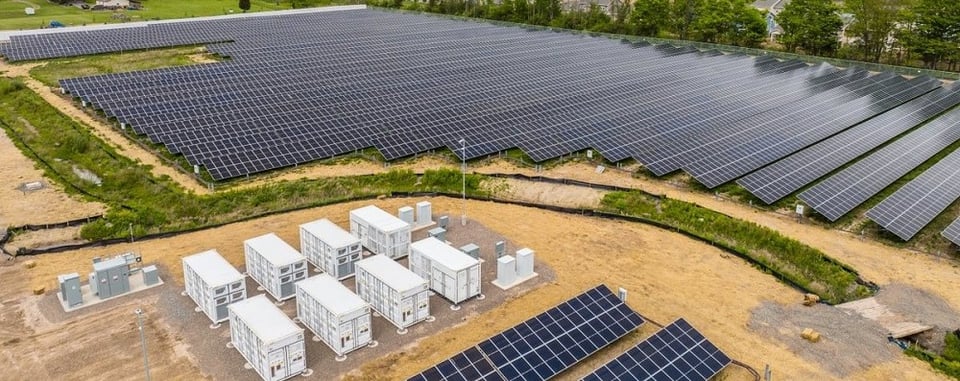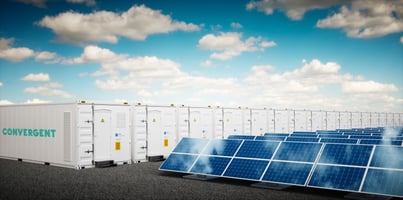Powering AI: How Energy Storage Can Help Utilities Meet Data Center-Driven Load Growth

U.S. data center energy demand, currently responsible for 3-4% of total electricity consumption, is projected to triple by the end of the decade, with AI as a major driver.
This growth brings challenges to utilities, including:
- Voltage fluctuations caused by sudden spikes in demand
- Frequency instability due to rapid increases in energy use
- Grid reliability concerns, as utilities must balance supply and demand in real time
Energy storage (typically in the form of battery storage) systems are emerging as a key solution to help utilities cost-effectively meet this growing demand. In this blog, we’ll explore how energy storage supports electric grid reliability, tackles additional challenges, reduces costs, and advances the energy transition.
What Is Causing the Growth in Energy Demand for AI Data Centers?

The rapid rise of artificial intelligence (AI) is fueling an unprecedented surge in energy demand, with AI-powered data centers at the forefront. These data centers, housing powerful servers that process enormous amounts of data, consume electricity at levels comparable to some small towns. Utilities and grid operators are under increasing pressure to ensure reliable power supply while maintaining low costs for their communities.
AI applications such as machine learning, natural language processing, and predictive analytics require vast computational power to process and analyze the large amounts of data they generate, adding further strain to data center infrastructure.
Moreover, the widespread adoption of cloud services, remote work, and e-commerce, alongside innovations like “smart cities,” are further contributing to the surge. As digitalization and electrification continue to evolve, AI data centers will likely expand in both scale and energy demand, making the case for energy storage more critical than ever.
How Energy Storage and Renewables Help with Growing Data Center Demands
AI data centers—housing servers that power applications like machine learning, natural language processing, and predictive analytics—consume significant amounts of energy. These facilities require consistent, high-capacity power to manage the increasingly complex demands of AI workloads. The grid, originally designed to handle a more predictable and centralized flow of power, was not built to accommodate this surge in energy needs.
Historically, power on the grid has flowed in one direction (from generation to transmission to distribution to customers) but with more and more customers producing their own power, i.e., solar panels at businesses or residences, power is now flowing in multiple directions. This shift has created new challenges, especially with the growing energy demand projected from AI data centers.
Renewable energy systems—including energy storage and solar photovoltaics (PV)—have a fundamental role to play in the modernizing energy infrastructure; energy storage, in particular is, the ‘backbone’ of a more sustainable and reliable electric grid.
Energy storage systems allow electricity to be stored—and then discharged—at the most strategic times. Today, Lithium-ion batteries, the same batteries that are used in cell phones and electric vehicles, are the most commonly used type of energy storage. Like the batteries in your cell phone, utility-scale battery energy storage systems can be charged with electricity from the grid, stored, and discharged when there is a deficit in supply or when energy is most expensive.
When battery storage is paired with solar PV (known as solar-plus-storage), utility-scale batteries can utilize solar energy whether or not the sun is shining.

Utilities are adopting battery storage and solar-plus-storage in growing numbers. The combination of solar arrays and utility-scale batteries provides a flexible, proven, multi-use solution to meet the grid’s 21st-century challenges, accelerating the modernization of energy infrastructure.
AI data centers require consistent and reliable power to process large amounts of data. Here’s how battery storage can help:
💪 Peak Demand Management: Utility-scale battery storage systems can store electricity during off-peak hours and discharge it during times of high demand from AI data centers, helping utilities balance the grid more effectively (grid reliability).
🔋 Backup Power: Battery storage systems provide critical backup power to ensure uninterrupted operation of data centers during shorter outages or periods of high grid stress. AI data centers rely heavily on uninterrupted power for essential operations, so any disruption is especially detrimental.
💸 Cost Management: Battery storage can help utilities keep costs low for their customers by deferring more costly system upgrades.
📈 Scalability and Flexibility: Battery storage systems can be deployed near AI data centers to enhance local grid stability and meet specific energy needs, offering tailored solutions for energy-intensive operations.
How to Get Started with Energy Storage
Financing, owning, and operating utility-scale energy storage and solar PV systems require expertise, which is why it is important to have an experienced partner (spoiler alert: that partner should be Convergent Energy and Power!).

Convergent Energy and Power (Convergent) has been in the energy storage industry since its infancy, almost 15 years ago. In that time, we’ve gained the relevant expertise, working closely with utilities across North America to take the hassle out of energy storage. We’re proud to say that it has never been easier to integrate energy storage into your utility there has also never been a more critical time to do so.
The scalability of energy storage systems is especially vital as AI data centers require more flexible solutions to handle fluctuating energy demands.
To learn more about how an energy storage system or solar-plus-storage can benefit your community, schedule a free, no-obligation introductory call with our team today.


